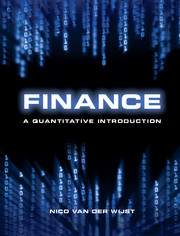Book contents
- Frontmatter
- Contents
- List of Figures
- List of Tables
- Acronyms
- Preface
- 1 Introduction
- 2 Fundamental concepts and techniques
- 3 Modern portfolio theory
- 4 Market efficiency
- Chapter 5 Capital structure and dividends
- 6 Valuing levered projects
- 7 Option pricing in discrete time
- 8 Option pricing in continuous time
- 9 Real options analysis
- 10 Selected option applications
- 11 Hedging
- 12 Agency problems and governance
- Solutions to exercises
- Glossary
- References
- Index
6 - Valuing levered projects
Published online by Cambridge University Press: 05 February 2013
- Frontmatter
- Contents
- List of Figures
- List of Tables
- Acronyms
- Preface
- 1 Introduction
- 2 Fundamental concepts and techniques
- 3 Modern portfolio theory
- 4 Market efficiency
- Chapter 5 Capital structure and dividends
- 6 Valuing levered projects
- 7 Option pricing in discrete time
- 8 Option pricing in continuous time
- 9 Real options analysis
- 10 Selected option applications
- 11 Hedging
- 12 Agency problems and governance
- Solutions to exercises
- Glossary
- References
- Index
Summary
Modigliani and Miller’s proposition 2 provides a basic relation for the distribution of risk and return over debt and equity holders. In this chapter we will elaborate that relation in more detail. This gives a good illustration of how the interaction between financing and investment decisions can be analyzed. However, the analysis is restricted by the fact that only one market imperfection, taxes, can be incorporated in return rates. The limiting effect of default costs is treated as an exogenous factor.
Basic elements
Risks and discount rates
In the Modigliani and Miller analyses we compared two companies with the same assets that produce the same cash flows. Such companies have the same business risk. Business risk is the uncertainty of the cash flows that are generated by the firm’s assets. It is the risk of, for example, operating a fleet of trucks, or a chemical plant, or a software company. The market price for this risk is the opportunity cost of capital, which is the return that the market offers on investments with the same risk characteristics as the investment we are looking at. If shareholders provide the whole investment sum, so that they bear all the risks and receive the entire cash flow, they will require the opportunity cost of capital as return. Shareholders express their requirements in the price they are willing to pay for the shares – they will set the price such that the expected return on the shares equals the opportunity cost of capital. If there are more categories of investors, financial contracts specify how risk and return are divided over them. The simple, stylized situation we will analyse involves a division of cash flows in a low-risk, low-return part for the debtholders, and a high-risk, high-return part for the equity holders. As we saw in the previous chapter, the additional risk that equity holders accept by giving debtholders a higher priority claim on the firm’s cash flows is called financial risk.
- Type
- Chapter
- Information
- FinanceA Quantitative Introduction, pp. 165 - 184Publisher: Cambridge University PressPrint publication year: 2013

